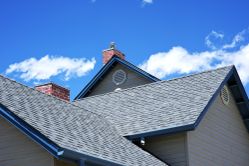How Does Roofing Affect Home Energy Efficiency?

Residential roofing plays a significant role in your utility bills and environmental impact. Choosing the right materials and features will lower the leaking of climate-controlled air, called air exchange. Below, learn some insight into this relationship so you can ensure the roofing doesn’t contribute to high energy costs.
Insulation
Attics must have adequate insulation to prevent cooled or heated air from escaping through the roof. The U.S. Department of Energy recommends that homes in Philadelphia use attic insulation between R38 and R60. This measurement refers to the thermal resistance of the material and offers a range of effective options to improve energy efficiency by keeping the heat in an uninsulated attic.
If your home already has attic insulation, you can lower air exchange by adding R25 to R30 insulation to the attic floor. This step can reduce hot and cold air loss, decrease the amount of fuel or electricity needed to warm and cool the home, and lower utility bills.
Ventilation
 Residential roofing must feature ventilation to bring fresh air into the attic and let out hot, humid air. Without vents, the attic may become warm and moist, making the HVAC work harder to cool or heat the house. These factors can also facilitate mold growth that lowers indoor air quality.
Residential roofing must feature ventilation to bring fresh air into the attic and let out hot, humid air. Without vents, the attic may become warm and moist, making the HVAC work harder to cool or heat the house. These factors can also facilitate mold growth that lowers indoor air quality.
Have a roofing team install soffit vents around the eaves to intake fresh air. Then, add vents near the roof peak to let out hot air that rises to the top of the attic. These features must be sealed with flashing. This metal material is installed where the roof meets the vents to direct precipitation away from the vents.
Some homes also feature ventilation in the kitchens and bathrooms to remove humid air and bad smells. These options can improve energy efficiency by transporting hot air from the oven or shower to the outside, ensuring your AC doesn’t work overtime to reduce their effects.
Coloring
Darker residential roofing hues can absorb heat from the sun, improving home energy efficiency in the winter by making the furnace work less to heat the building. Lighter-tone roofing materials will reflect UV rays, reducing AC bills in the summer. Houses in places with all four seasons benefit from neutral grey shingles that absorb heat in the winter and reflect it in the summer.
People looking to improve energy efficiency for commercial or residential roofing should contact Four Seasons Roofing and Siding in Philadelphia, PA. The family-owned team has more than 20 years of experience, offering fair prices for top-notch materials and workmanship. Call the company at (215) 743-3319 to learn about their services.
About the Business
Have a question? Ask the experts!
Send your question

